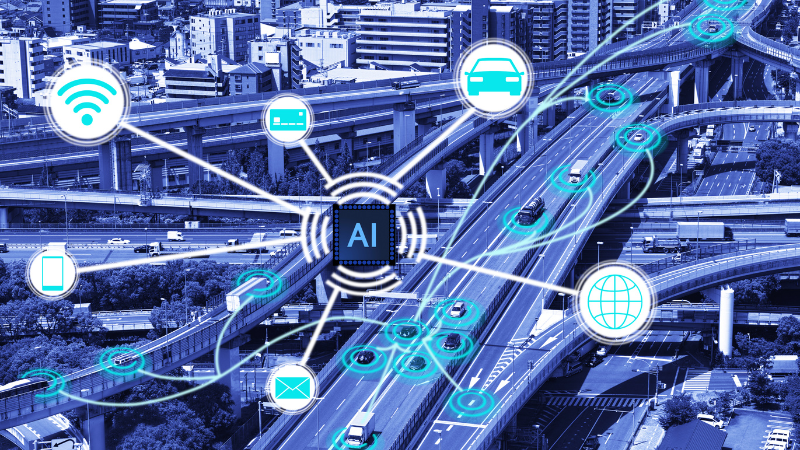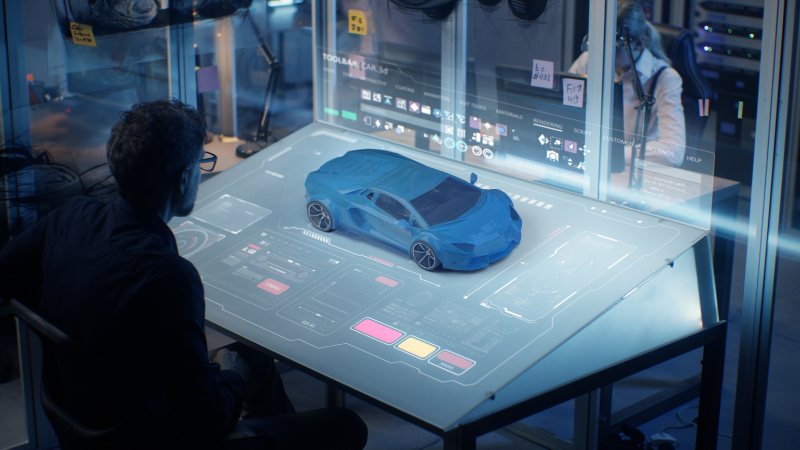Will cars fly in our future? Probably not, but they will have AI-powered embedded systems! The automotive sector is undergoing significant changes to adapt to a new era of AI-technology.
The digitalisation and modernisation of this sector have enabled engineers to develop innovative and improved vehicles that not only enhance quality and safety but also elevate the overall driving experience. AI-powered embedded systems take automotive manufacturing to the next level, providing a competitive advantage for automakers.
However, this transition also is a driving force behind the skills gap in embedded software development, posing a challenge for companies striving to lead in automotive innovation. How will AI impact embedded systems in vehicles, and how can companies find the right professionals with these specialised skills?
AI Investments in the Automotive Sector
Automotive companies are shifting from a mechanical-driven approach towards an AI- and software-driven strategy, as revealed by McKinsey in a workshop with 30 European automotive and manufacturing executives on the future use of AI in their companies. The participants completed a survey in which more than 40% stated that they had invested up to €5 million in generative AI research and development. For 10% of respondents, this figure even exceeded €20 million.
Although 70 per cent of these companies are integrating generative AI applications into R&D, most pilot programmes are still in the early stages of the R&D process. This raises the question of why it is so difficult to implement AI systematically in R&D.
Another report from IBM surveyed more than 1,200 global automotive industry executives on their expectations for the sector in 2035. They predict that 74% of vehicles in 2035 will be software-defined and AI-powered. As a result, 51% of their revenue in 2035 will come from recurring digital and software-related sources, such as autonomous driving, enhanced driving experiences, and functional upgrades. To not miss out on this opportunity, automakers are expected to triple their R&D budgets, increasing from 21% today to 58% by 2035.
AI-Powered Embedded Systems
1. Advanced Driver Assistance Systems (ADAS) and Autonomous Vehicles (AVs)
AI will play a crucial role in embedded systems within ADAS, thanks to real-time data from cameras, LiDAR, ultrasonic sensors, and RADAR. These technologies detect pedestrians, hazards, traffic signs, and objects, using that information to enhance safety. By improving features such as adaptive cruise control, lane departure warning, automatic emergency braking, and blind-spot detection, vehicles are becoming safer than ever.
These advancements in ADAS also stimulate the development and reliability of AVs. ADAS helps to correct human error, making it possible to advance autonomous driving. According to the IBM report, 65% of executives believe that customers will expect autonomous driving features by 2035. However, only 23% of executives think level 4 and 5 features will be achievable due to technical challenges, regulatory frameworks, and societal acceptance.
The five levels of autonomous driving are:
Level 0: No automation
Level 1: Driver assistance
Level 2: Partial automation
Level 3: Conditional driving automation
Level 4: High automation
Level 5: Full automation
2. Predictive Maintenance and Energy efficiency
AI algorithms in embedded systems will analyse vehicle sensor data to predict component failures before they occur. This not only reduces costs but also improves vehicle reliability and safety.
Although AI-driven software will be beneficial for car maintenance, there is a paradox. The more software a car has, the more complex its maintenance becomes. Therefore, embedded systems need to be simplified and made maintainable with the help of optimised data management, streamlined software systems, and standardised hardware platforms.
Beyond maintenance, AI-driven embedded systems also optimise battery and energy management. Today, EVs typically have a range of between 100 km and 500 km. AI-embedded systems will enhance energy consumption in EVs by managing battery usage and improving charging efficiency through advanced algorithms. For example, AI-embedded systems can monitor battery health and suggest optimal charging points to maximise battery life and driving range.
3. Infotainment
Automakers that invest in new and exclusive AI-driven features to enhance the overall driving experience will gain a competitive advantage in the automotive sector. Infotainment systems provide a customised entertainment and driving experience, which is highly valued by many drivers.
Consider the integration of ChatGPT in Volkswagen’s IDA voice assistant to enhance voice control capabilities or the BMW Operating System X, which strengthens the BMW brand and reduces their digital and technological dependence on third parties.
Another feature of AI-powered embedded systems is traffic optimisation, achieved by using real-time data to predict traffic patterns and suggest optimised routes. Machine learning algorithms further enhance this feature by recommending routes based on driver preferences and traffic conditions.
Beyond AI-driven voice assistants and traffic optimisation, machine learning models analyse patterns and driver behaviour to personalise driver profiles. This includes automatically adjusting seat positions, entertainment preferences, and driving modes for a more tailored experience.
4. Enhanced Cybersecurity for Vehicles
One of the most pressing challenges of AI-embedded systems in vehicles is cybersecurity. Due to the vast amount of data being collected and analysed, any sensitive and private information must be protected. IBM states:
“A secure-by-design approach, embedding security and privacy throughout the product lifecycle, can help bolster defences.”
Elmar Pritsch of Deloitte Consulting GmbH also highlights:
“In contrast to the zero-fault mentality in traditional product design, software isn’t free of bugs and may never be fully ready. OEMs should reduce complexity and establish an SDV onboard architecture with an SDV-operated backend for instant bug fixes and security patches. The most successful OEMs will leverage this platform to create additional value, offering new features and third-party services throughout the vehicle lifecycle.”
Beyond cybersecurity itself, having a robust security system also provides automakers with a competitive advantage. According to IBM’s Automotive 2035 report, cybersecurity is one of the most crucial factors in defining competitive advantage. However, due to the long lifespan of vehicles and the continuous evolution of cyberattacks, cybersecurity remains a major challenge for most automakers.
A few key solutions to enhance vehicle security with AI-embedded systems include Vehicle Security Operations Centres (VSOCs), Intrusion Detection Systems (IDS), and a secure-by-design approach. All these solutions aim to prevent, monitor, and respond to security incidents effectively.

5. Vehicle Manufacturing and Quality Control
Embedded systems aren’t only integrated into the final product but also play a crucial role in the manufacturing and quality control processes. With AI-driven embedded systems, automakers can streamline, improve, and accelerate production, ultimately leading to faster delivery, better solutions, and fewer errors.
One example is Computer-Aided Design (CAD) tools, which automate and speed up design processes. In addition to generating possible designs, these tools also compare models against performance parameters. Another example comes from BMW, which has developed a GenAI assistant to accelerate infrastructure optimisation on AWS for more than 450 DevOps teams.
AI-powered embedded systems in factories also automate quality inspection, defect detection, and production line optimisation. Embedded AI systems monitor real-time data from sensors and IoT devices, optimising workflow and identifying inefficiencies before they impact production. AI further enables predictive maintenance for factory machinery, reducing downtime and ensuring uninterrupted manufacturing operations.
A good example comes from Audi, which uses AI to check whether individual welds are properly executed and to detect cracks in pressed parts, thereby improving the quality control process.
The Impact of AI on Embedded Recruitment
Skills Shortage
IBM revealed in their automotive report for 2035 that 74% of executives say they have a strong mechanical-driven culture, which is difficult to change. The challenge for executives is that they need employees who possess both software development as traditional vehicle engineering skills. Because of these niche requirements they don’t except to have this talent to achieve their software goals until 2034.
The demand for skills in embedded systems has shifted from a mechanical-driven approach to an AI-driven approach, requiring skills like data analysis, machine learning algorithms and hardware integration.
Above that, because of the collaborative environment professionals don’t only need the right experience and hard skills, but also soft skills like team management, communication and organisation.
Recruitment Strategies
The combination of teamwork skills and niche expertise makes it particularly challenging for automakers to find the right embedded systems professionals to integrate AI-driven embedded systems into their automotive strategy. Companies are not only competing with their direct competitors but also with other technology sectors that require embedded systems specialists with AI knowledge.
Of course, there are some in-house recruitment and HR strategies that automakers can implement, such as:
Internal training programmes
University and trainee programmes
Another option is to partner with a specialised embedded systems recruitment organisation. These organisations typically have access to a broader talent pool than most automakers, increasing the likelihood of finding the right experts.
Recruiters can also help reduce costs by sourcing candidates more quickly and managing the hiring process. The expenses associated with in-house recruitment can then be reallocated to other HR initiatives or departments to improve cost efficiency.

How Can Amoria Bond Help Automakers?
Amoria Bond has over 15 years of experience in the STEM recruitment sector, building a global talent pool of embedded systems professionals and automotive engineers. With specialised teams across multiple continents, our recruiters have successfully placed numerous niche-skilled embedded software engineers in the automotive sector.
Our teams specialise in:
Hardware design
Software development
Systems engineering
Verification and validation
Security
Real-time systems
Systems testing
The benefit of partnering with Amoria Bond isn’t only that we identify the best candidates for your role, but we also provide 360° HR solutions throughout the entire hiring process, ensuring a tailored and efficient solution to meet your recruitment needs.
Would you like to learn more about how our recruiters can help with staff shortages, niche skill requirements, and the war for talent? Contact me or my team today to discuss your hiring needs!







